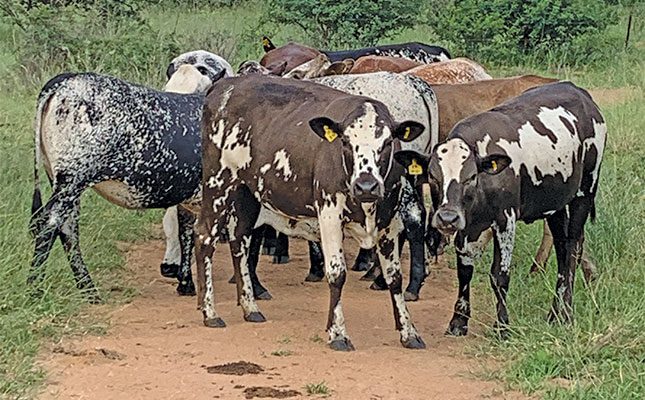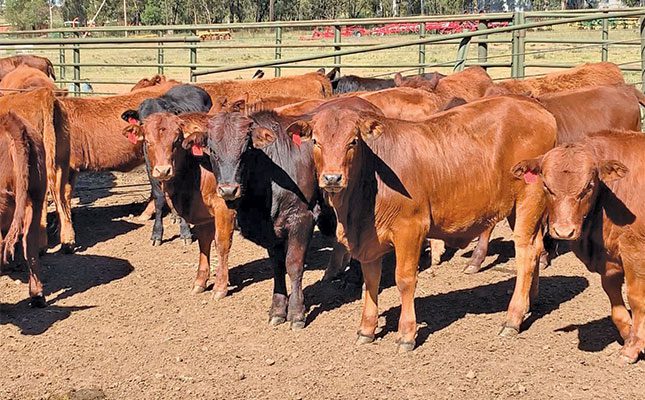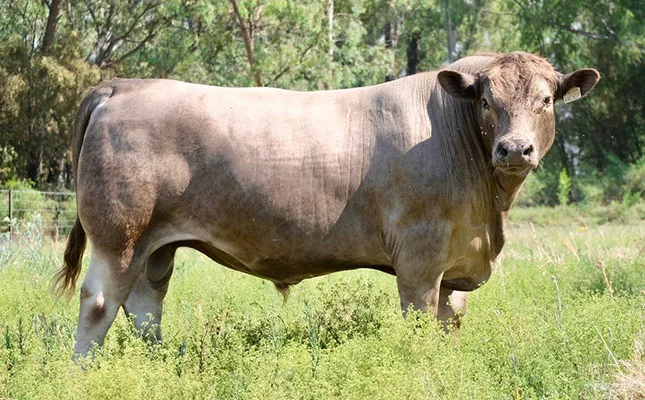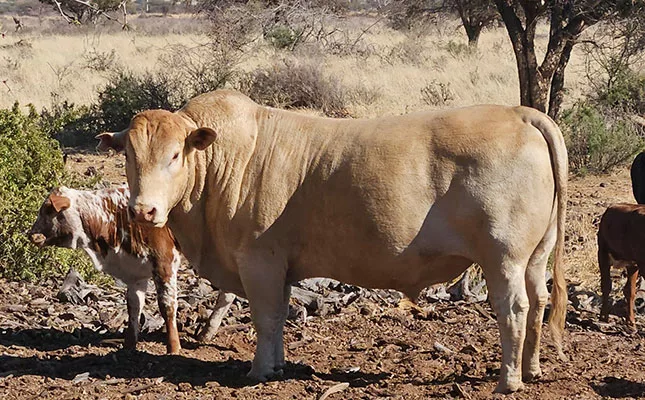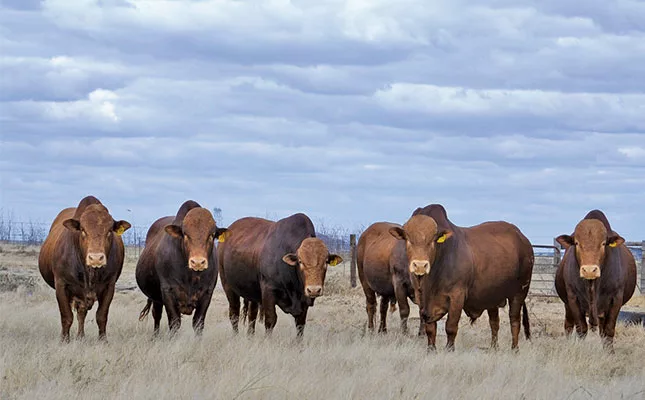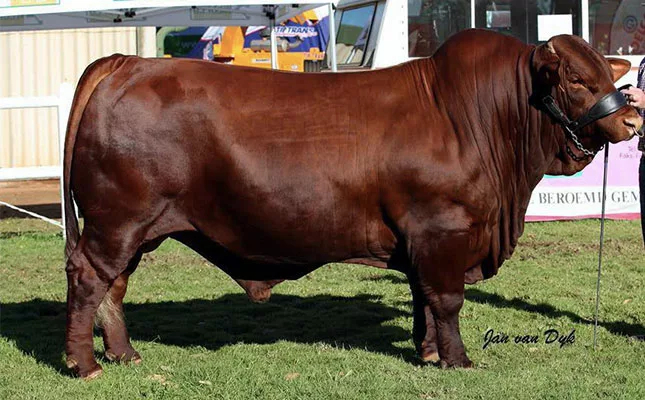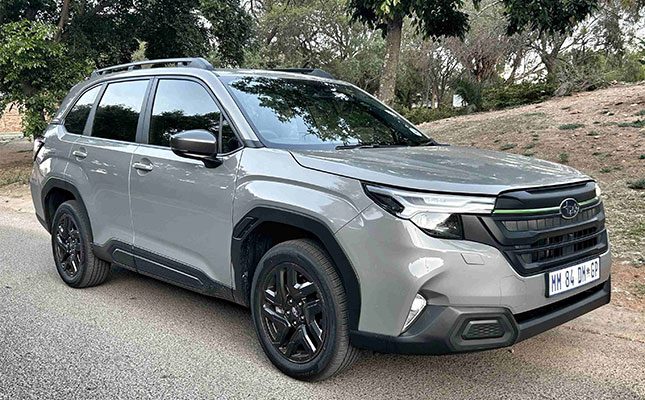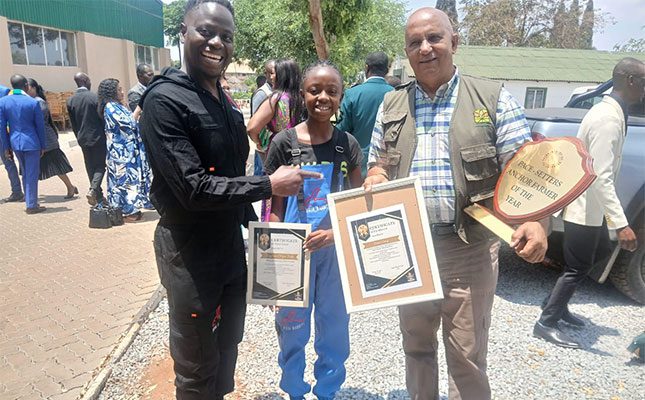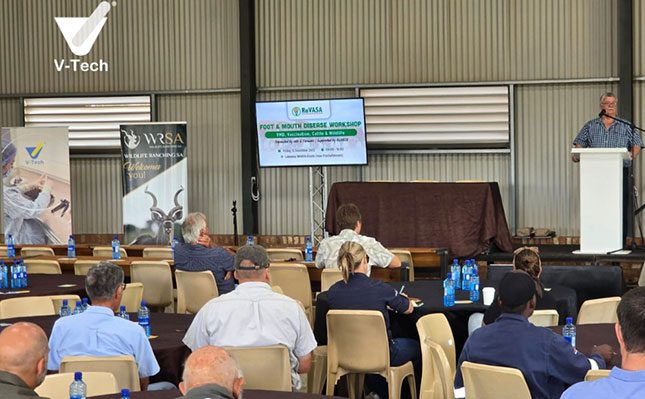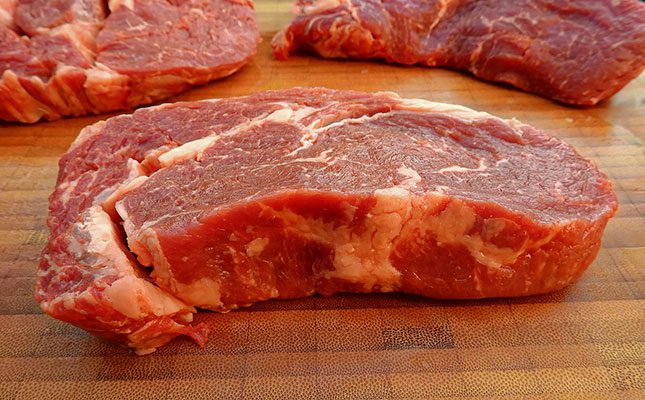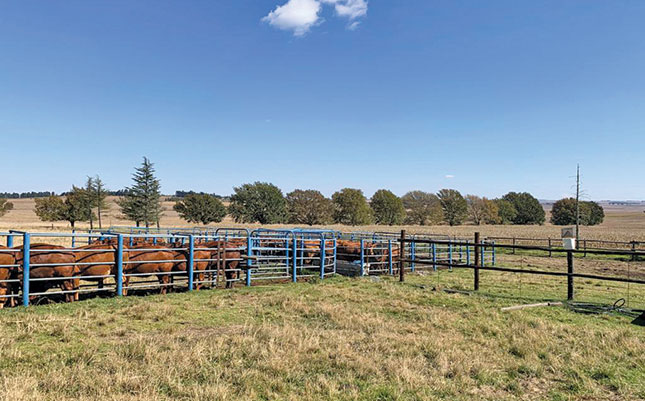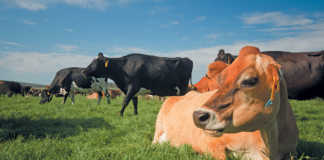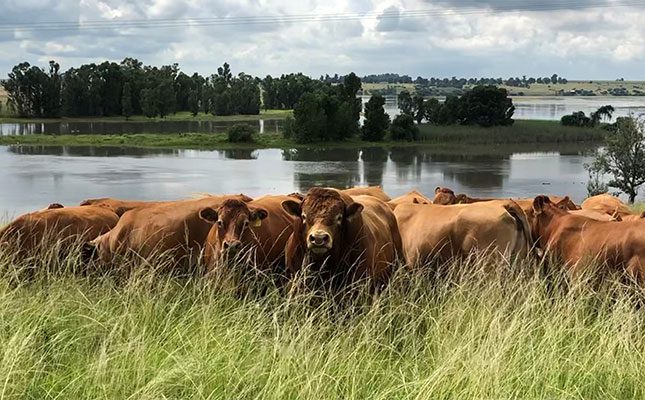
Photo: Supplied
John and Tracey Devonport are the proud owners of Devlan Limousins, a well-known Limousin stud situated at Water’s Edge on the Vaal Dam in Mpumalanga. They bought the farm in 1988, and established Devlan Limousins in 1991.
Devlan Limousins has won many awards and acclaims over the decades, with the most recent award being bestowed upon the cow Devlan Kelly DL 21 156, who was awarded the South African Champion of Champions at Nampo Alfa 2024 by renowned international judge PJ Budler.
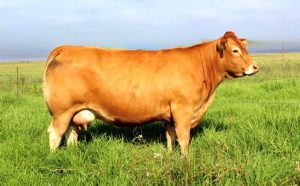
The competition for this category was stiff, with Devlan Kelly competing against eight Interbreed Gold Cup winners. Devlan Limousins also bred three of the female finalists, and two of the bull finalists.
Budler described Devlan Kelly as an incredible animal, with a bright future. “[She is] balanced, feminine, and maternal, with enough muscle for a female without being coarse.
She has tremendous centre-body dimension, is sound, has good feet and legs, and is flexible through her shoulders, and follows with a good hind leg.
She has good foot quality, a beautiful udder, nice and level udder floor, abundant milk flow, beautiful teat size and placement, and good fore udder attachment as it blends snugly into her body wall. She has height and width in her udder, and when you see her move away, you see the fullness of her udder to go with that meat and muscle.”
Starting out
Tracey and John met at Wits University and were married in 1985. In November 1988, the couple bought their first farm: a 205ha parcel of land on the Vaal Dam.
“Tracey had a much bigger vision for the farm than I, and over the years we managed to acquire six more adjoining farms,” says John.
Water’s Edge now comprises 1 350ha, with 20km of waterfront.
John, a chartered accountant, and Tracey, an award-winning financial planner who was recently inducted as a laureate into the Financial Hall of Fame at its inaugural meeting in Canada, decided to put all their farms into trusts, a valuable lesson for other farmers and landowners.
“By putting our farms into trusts, they can be passed down from generation to generation, while avoiding onerous taxes,” says John.
He also advises aspiring farmers to ensure that the land they purchase has water-use rights. He adds that it took them 15 years to register and legitimise the water-use rights on their farms.
John and Tracey currently have two centre pivots, which enable them to produce maize and silage. These, says John, are the biggest input costs when running a stud. Producing maize and silage themselves thus allows them to significantly cut costs.
“This competitive advantage makes the cattle operation sustainable, profitable and bulletproof,” says John.
From commercial to stud farming
The original farm was a ‘khaki bush’ factory, says John, and Brahman cattle were originally brought in to clear the farm of the weeds after the farm was burnt and cleaned.
The Devonports bought their first Limousin bull (Baron VD 90 003) from Willie van Eden in 1992, which was used on the Brahman female animals.
“The hybrid vigour of this cross was utterly amazing, and we regularly won the ‘slaughter ox’ and ‘best of four’ awards in the Karoo Osche- and Rassie Lombard-organised Vereeniging carcass competitions against some strong competition.”
John says it was their first Limousin bull that produced such remarkable crossbred animals.
“Tracey and I fell in love with this impressive- looking animal that bred so well,” says John.
“We subsequently bought in three young Limousin heifers, which led to the establishment of the Devlan Limousin stud.”
Over the years, John and Tracey bought in more Limousins which they purchased at dispersal sales. They eventually bred a bull which they believed showed great potential.
At the Bloem Show in 1997, this young bull was put on the side of the show ring. While John and Tracey believed that he had won his class, he had actually been disqualified.
“This was a big wake-up call for us, and we realised we were in desperate need of help if we were going to make a success of the stud,” says John.
Making inroads
John and Tracey were introduced to a mentor in the form of Chris Marais, a lecturer at the Potchefstroom Agricultural College.
“Chris put cattle breeding into perspective for us,” says John. “He started by looking at the average weights of South African Limousin cattle, according to data provided by the Agricultural Research Council.
“He told us that our main goal needed to be to breed animals suited to our environment, which are well adapted to the Vaal Dam area, and weigh the averages.”
However, John and Tracey were advised that while some of the animals they bred would be smaller than the average, and some would be bigger, they needed to avoid the extremes of too big and too small.
“Middle-of-the-road and well-balanced animals were the answer. Chris told us to weigh our growing animals regularly so we could gauge where we were in terms of targeted averages,” John says.
Marais also looked at functionally efficient animals based on how their jaws were set, their walking ability, their hooves and legs, and their udders and testes. ‘Sausage-looking’ animals with no capacity, bad temperament, loins and top lines, and infertile animals with the wedge the wrong way were excluded.
Marais also took a look at the stud’s fertility records. Female animals had to be feminine and fertile, while bulls needed to be masculine, with a lot of muscle.
“In accordance with his strict selection policy, Chris removed one-third of our herd and made them commercial animals. It was a very tough financial decision, but a lesson well learnt,” says John.
In 1998, John and Tracey took three animals selected by Marais to the National Show in Bloemfontein. With these animals, Devlan Limousins won seven first places.
“At that point, the bug had bitten, and we were enthusiastic and inspired by this success,” says John.
But it wasn’t smooth sailing from then on out, however, and John and Tracey later learnt that hard- muscled animals did not get places in the interbreed show ring.
“Animals in this category must be the right type, easy fleshing, and early maturing. They must be softer muscled with depth and capacity, shorter on the leg and well adapted to Southern African conditions,” says John.
John and Tracey also accredit Dr Michael Bradfield for his influence on the Devlan Limousins stud, particularly with regards to using Breedplan and scientific breeding methods.
“We were awarded the Southern African Breeder of the Year award in 2006 and have won the Limousin Cow Group award of the year on numerous occasions. This is because of the fertility of our herd, and submitting our animals’ weights regularly. This has resulted in us being rated 4,5 stars for Completeness of Performance,” says John.
Despite having many mentors, John and Tracey have also had to educate themselves over the years. John says they read as much as they could on the topic of farming and breeding, as well as attending the annual Stockman School.
“This helped us expand our minds and stay informed on the latest trends and shortfalls in the South African beef industry,” says John.
While now stalwarts in the industry, John and Tracey still attend the Stockman School, having attended as recently as 2024.
“We picked up many good points, which will help our herd going into the unknown future,” says John.
Budler was at the Stockman School in 2024, and offered some novel, practical and common- sense ideas on cattle breeding, says John.
“Like Chris, he focuses on adaptable, functionally efficient animals that must be fertile. However, the ‘breath of fresh air’ was longevity, which he places great emphasis on. For example, if your older cows become pregnant and produce a live calf, they stay in the herd. Many Limousin cows produce 15 calves or more, which is a tremendous strength of the breed. Replacement heifers are expensive to grow out and to keep before they calve,” says John.
Even with almost four decades of experience, John and Tracey still consult experts in the field for advice.
“We currently use Marius Barkhuizen, a respected interbreed judge and breed adviser at Droughtmaster, as our sounding board. We also consult him to get a second opinion about our show animals,” says John.
Marius was the interbreed judge of the Parys Show 2024, whom named Devlan Kelly the Gold Cup winner. He correctly predicted she would win Nampo Alfa.
Artificial insemination
Artificial insemination (AI) and embryo transfers (ET) increase the genetic diversity of a farmer’s herd, says John, if the farmer uses top-quality animals.
“We haven’t been that successful when compared to other Limousin breeders, and it has risks and can be expensive,” warns John.
However, John and Tracey have had some success using AI and ETs: the influential bull Devlan Stavely Hercules (DK 03 43) was bred using AI. Hercules has been used in 16 different herds, and has produced over 350 offspring.
AI was also used on Devlan Geisha Girl (DL 11 45), when she was inseminated with semen from RE 93 19 (Uron x Cachou combination, bred by Norman Bauer), and became the National Champion Female in 2019.
Geisha Girl produced an impressive bull (Devlan Lake DL 16 11), who sired Amazing Grace (DL 19 158) and Devlan Kelly (DL 21 156), who was crowned the South African Champion of Champions.
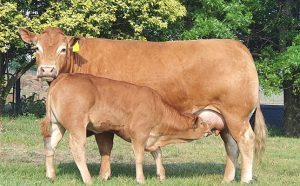
“We normally do AI on our heifers and use new genetics on proven bulls who consistently perform, with a 40% conception rate,” says John. This conception rate, he admits, needs more work.
ETs, on the other hand, are used to replicate top-quality genetics in one year. This is because embryos are produced using genetic material from top-quality female animals (donor cows) and bulls.
These embryos are then implanted into recipient (or surrogate) female animals. As such, a farmer’s top- quality female animals can produce many calves in one year.
“The trick here is to prepare your recipients very well,” says John. “You should have a slightly better conception rate using fresh embryos rather than using frozen embryos.”
However, John says, they have not yet bred any animals of significance with his method, and conception rates have been disappointing.
For the most part, John and Tracey use natural mating methods in the stud.
Inbreeding or line breeding?
“Prof Frikkie Neser and Dr Bradfield have always believed in genetic variation and that no inbreeding should be used at all,” says John. “We have always followed this principle religiously.”
However, Budler and other successful breeders have great faith in line breeding to replicate the good attributes of an animal. “There’s a saying that goes: if it’s successful, it’s line breeding. If it’s not successful, it’s inbreeding. We will do some selective line breeding in the future,” says John.
Breeding strategy
“Breeding is about numbers and statistics. Computer systems like Breedplan analyse profitable traits and convert that data into readable reports. We try and breed with dominant cow families and strong maternal lines that are pleasing to the eye.”
By using well-adapted, functionally efficient, fertile, feminine cows with longevity and good capacity, and pairing them with early maturing, easy fleshing and masculine, well-muscled bulls with good genetics, John and Tracey have managed to wean between 80% and 85% live calves, and produce two to three exceptional animals per exposed 100 cows.
John adds that the simpler the breeding strategy, the better.
“We use the KISS principle: keep it simple, stupid! This is a strategy that has consistently worked well for Devlan Limousins.”
For farmers with ample grazing, John suggests keeping herds with 50, 75 or 100 top-quality female animals that are fertile and functional and well adapted to the farm.
“Use masculine, well-muscled bulls who have proven themselves with reliable and predictable outcomes. This will enable you to breed an exceptional animal consistently.”
Breeding the best
Every farmer’s dream is to breed the perfect animal. But this takes patience, and patience, and even more patience, says John.
“Chris told me that it’s something that I’ll never achieve in my lifetime. These are wise words from an experienced stockman!”
Farmers experience tremendous challenges, setbacks and heartbreak, especially when losing a good animal, and when they are deeply involved and connected to the ‘beautiful game’ of breeding the best.
“However, if you love and enjoy what you do, you will be resilient, have perseverance and you will perform with passion and achieve success. It is exhilarating when a plan comes together,” says John.
Visit devlan.co.za.

